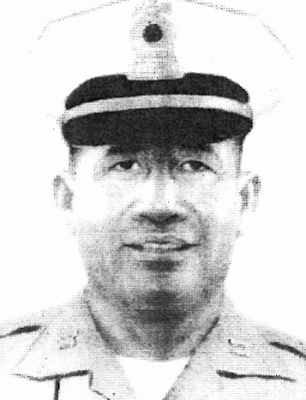American sailors and Chamorros dance right after the war
Gi despues de gera nai ma susede este.
(This happened after the war.)
Un puenge, kåsi guennao gi oran a las sais, man ma kombida håye malago' para u fan baila
(One night, around 6 o'clock, anyone interested was invited to dance)
yan i sendålon Amerikåno siha.
(with American soldiers.)
Ha sede si tatan-måme para in fan hånao, hame yan i mañe'lu-ho famalao'an,
(Our dad allowed us to go, me and my sisters,)
lao solo yanggen ha ga'chunge ham si nanan-måme ya guiya u pinilan ham.
(but only if our mother accompanied us and she would chaperone us.)
Man magof ham todos sa' månnge' todo.
(We were happy because everything was enjoyable.)
Pues, måtto un kapitan gi as nanå-ho ya finaisen nu guiya,
(Then, a captain came to my mother and asked,)
"Señora, maila' ya ta fanu'e este siha haftaimano magåhet ma baila i Lindy Hop."
(Ma'am, let's show these people how the Lindy Hop is really danced.)
Ti malago' si nanå-ho bumaila ya sige ha' mama' eskusu si nanå-ho na ti ha tungo' bumaila
(My mother didn't want to dance and kept making excuses that she didn't know how to dance)
lao sige ha' lokkue' i kapitan ha apreta si nanå-ho.
(but the captain also kept pressuring my mother.)
En fin, kumonsiente si nanå-ho ya ma tutuhon i dos bumaila.
(In the end, my mother agreed and the two started to dance.)
Ai lokkue'. Tåya' dies minutos måtto påpa' si tatan-måme ya ha go'te kannai-ña si nanå-ho
(Oh dear. It wasn't ten minutes and our dad came down and grabbed my mom's hand)
ya ilek-ña, "Nihi! Todos hamyo nihi tåtte gi gima'! Ni håyeye na låhe para un tinektok!"
(and said, "Let's go! All of you let's go back to the house! No man is going to hug you!")
Pues man hånao ham todos tåtte gi gima'-måme.
(So we all went back to our house.)
Man triste ham sa' pot si nanan-måme ti man baila ham åpmam ayo na puenge.
(We were sad because of our other we didn't dance long that night.)
CULTURAL NOTES
1. This family was of the "respectable" class, very religious and Spanish-influenced. Dancing, in general, was frowned upon as an occasion of sin. The father would not allow his teenage daughters to go to the dance unless the mother was there to keep an eye on them. The fear of dancing came from concern over physical touch. Notice the husband's remark that he would let no man hug his wife, even in dancing with many witnesses present.
2. How did the dad find out about the wife's dancing? Nothing stays a secret very long in our islands. Someone saw the married woman dancing with an American officer and made sure the husband heard about it.
3. The husband's displeasure could be more centered on a fear of being talked about by the community, rather than on any fear of an American officer's contact with his wife. Had the wife danced longer with the officer, and the husband never put a stop to it, people might gossip about the wife and her husband's ignorance of her behavior, or his indifference to it or his inability to correct his wife's behavior.
4. The mother's reaction is also telling. Two cultural factors were in tension within her. First, she instinctively knew she couldn't dance with the officer. That would be against the norm. Yet, there was another cultural norm and that was to please the other, especially an American and more so an American military officer. She had to weigh the two forces within her and the norm to please the other won out, probably because she thought it was a harmless dance, with her daughters present to vouch that it was just a dance and maybe she could do this one dance and be over with it. The trouble was that others were watching, too, and got word back to her husband.
The Lindy Hop














